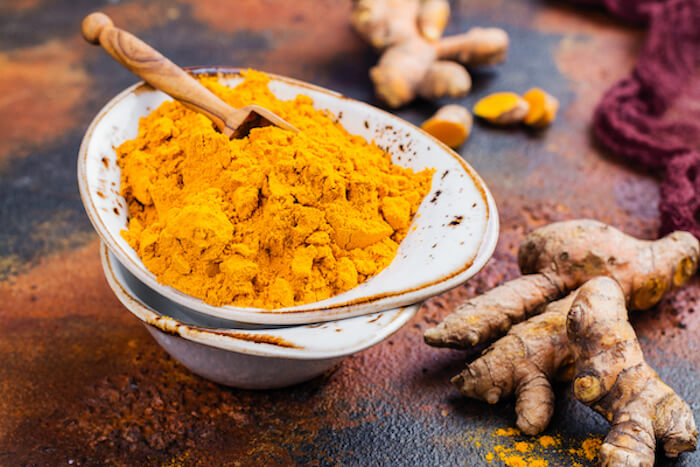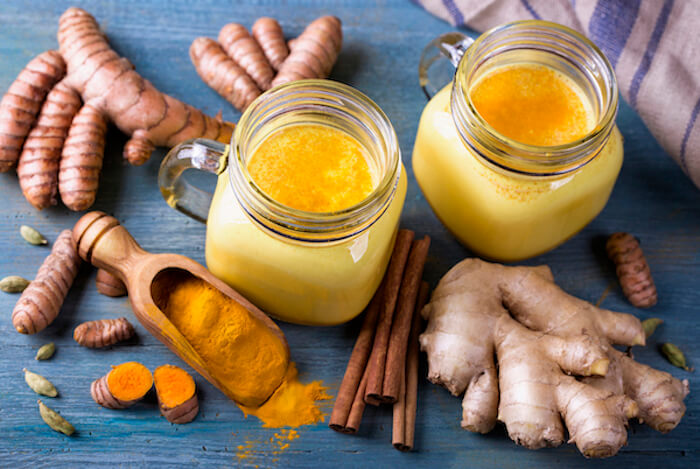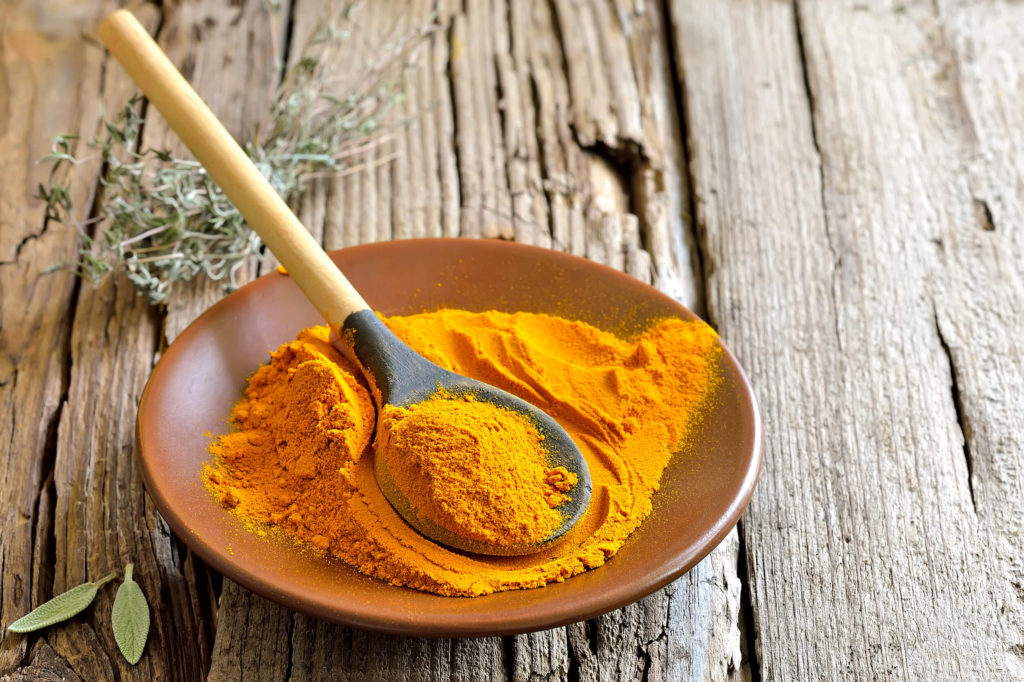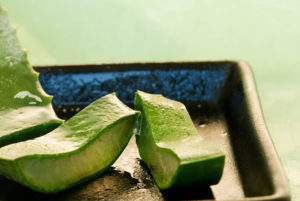Among all the medicinal herbs, turmeric is the one with the most wide-ranging scientific validation. Though originally used in Ayurveda and Chinese Medicine, tens of thousands of western scientific studies have been conducted, verifying the health benefits of turmeric (and its active ingredient, curcumin).
But is it really a herbal powerhouse?
Here we’ll introduce some of turmeric’s numerous health benefits, and offer tips on how to include it in your diet and/or as a supplement.

Scientific Evidence For The Benefits Of Turmeric
As Dr. Axe reports, there currently are more than 12,500 peer-reviewed articles published that prove the benefits of turmeric—and particularly one of its primary healing compounds: curcumin.
Some of the impressive health benefits of turmeric include:
→ Improving skin health
→ Fighting inflammation
→ Regulating cholesterol levels
→ Outperforming common arthritis drugs
→ Slowing or preventing blood clots
→ Reducing depression symptoms
→ Treating or preventing certain types of cancer
→ Helping to manage diabetes
→ Combating obesity (by reducing the proliferation of fat cells)
→ Helping to manage Irritable Bowel Syndrome (IBS)

Turmeric & Brain Health
Turmeric has also been shown to help the human brain heal itself. How is this possible?
As mentioned above, the active compound of turmeric is curcumin. And curcumin has strong anti-inflammatory and antioxidant actions—both of which provide nourishment and support to the brain.
As reported in Medical Daily, Turmeric and its active components show great promise in the treatment of neurodegenerative diseases such as Alzheimer’s, Parkinson’s, multiple sclerosis, amyotrophic lateral sclerosis (ALS), and Huntington’s disease. Turmeric can also help to improve overall brain health and vitality—for anyone interested in improving cognitive function.

Turmeric In Ayurveda: The Golden Goddess
Turmeric has been used for many centuries in Ayurveda—the 5,000-year-old natural healing system that originated in India.
Many people know turmeric primarily as the staple in Indian curry dishes. It’s what gives these dishes their golden-yellow color. Because of its color, along with its healing powers, turmeric is sometimes referred to as “the Golden Goddess.”
In Ayurvedic medicine, turmeric is believed to balance the three doshas: vata, pitta, and kapha. In so doing, it has wide-ranging therapeutic benefits.
As Lisa Gallant reports in her article The Golden Goddess:
“Turmeric has been proven effective in treating some of the most intense ailments afflicting the world today including: Arthritis, Cancer, Alzheimer’s Disease, Diabetes, Multiple Sclerosis, Atherosclerosis, HIV/AIDS, Sexually Transmitted Diseases (Hepatitis-C, Genital Herpes) , Irritable Bowel Syndrome, Indigestion, Inflammation, Acne, Urinary Tract Infections, Kidney Infections, Gallstones, Anemia, Hemorrhoids, Liver Disease, Leprosy, Amenorrhea, Edema, Bronchitis, Common Cold, Headaches, Conjunctivitis, Bursitis, food poisoning, parasites, fever, diarrhea, poor circulation, lower back and abdominal pain.
It can also be used as a mosquito repellent, wound healer, and immediate cure for scorpion stings. Turmeric helps balance the female reproductive and lactation systems, and in men it purifies and improves the health of semen. It is used to treat external ulcers that would not respond to other treatment. Due to its vast array of medicinal purposes and versatility, turmeric is one of the most important herbs in any natural medicine cabinet.”
Pretty impressive, right?!
Turmeric In Chinese Medicine
Not surprisingly, turmeric is used also in Chinese herbal medicine. In this natural healing system, turmeric belongs to the category of herbs that “regulate/rectify the blood.”
In Chinese medicine, the two parts of the turmeric root are used separately:
* Yu Jin (turmeric tuber, i.e. thick part of the root); and
* Jiang Huang (turmeric rhizome, i.e. thin part of the root).
One of the main uses of turmeric in Chinese herbal medicine is to help relieve certain types of physical pain. One of the therapeutic actions of Jiang Huang (turmeric rhizome), for instance, is to resolve aches and pains that are the result of stagnant qi or blood stasis, or that are caused by wind-damp painful obstruction.
Mirroring this traditional use, turmeric is one of the main ingredients in Curica Pain Relief—a product that’s intended as an herbal alternative to aspirin or Ibuprofen.

How To Include Turmeric In Your Diet
As we’ve seen, turmeric has a truly impressive variety of health benefits. It supports healthy skin, decreases arthritic pain, improves brain function, and reduces symptoms of depression—to name just a few.
All in all, turmeric is a fantastic spice to keep on hand—and include in your diet regularly. And, happily, there are several ways that this can happen. For instance:
* Include ground turmeric in your daily cooking, e.g. when making Indian curries or a variety of other dishes that can feature this healing spice.
* Take a turmeric supplement—e.g. Turmeric Supreme—which includes black pepper to enhance absorption of the herb.
* Take a curcumin supplement—e.g. Theracurmin—which isolates the most therapeutically potent biological component of Turmeric.
* Get in the habit of drinking Golden Milk—a delicious warm drink that combines Turmeric with dates other herbs/spices.
YOU MAY ALSO LIKE:
CHAKRA BALANCING GEMSTONES
If you feel sluggish and lack energy, you can be sure that your chakras are not functioning properly. Since chakras govern…
THE HEART’S INTELLIGENCE: NEW BREAKTHROUGHS IN MIND-BODY HEALTH
There’s a scene in the inspirational movie I Am in which famed comedic director Tom Shadyac shows up at the HeartMath…
YOGA AND CONSCIOUS BREATHING FOR ANTI-AGING
By Esse Johnson I believe that a primary reason for getting older and wiser has become such a physically painful ordeal…
YOUR SKINCARE SUPER-HERO: THE MYRIAD BENEFITS OF ALOE VERA
THE SKIN: OUR LARGEST ORGAN Did you know that the skin is our largest organ? It’s true! And because it’s our…
THERE IS A 100% TOXIN-FREE WAY TO DYE YOUR HAIR
Much to their collective horror, women are learning about the dangers of toxins in their beauty supplies. Thanks to organizations like the…
COULD AN ACUPRESSURE MAT IMPROVE YOUR HEALTH AND WELL-BEING?
The ancient practice of acupuncture is firmly established as a healing and wellness therapy. It works on the theory that by…







